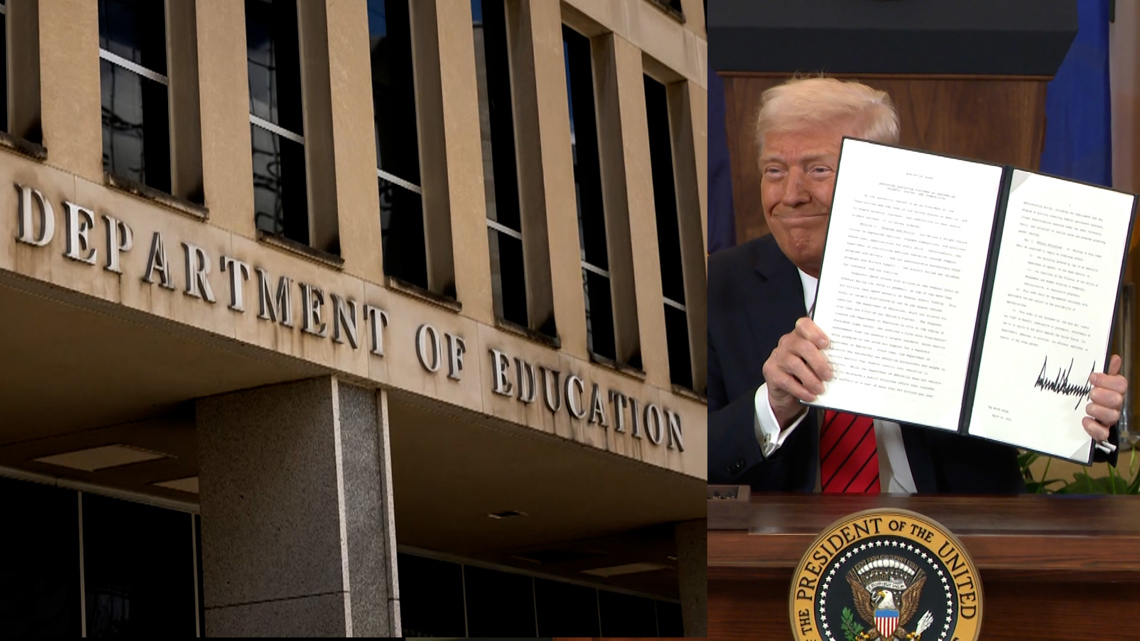
President Trump signed an executive order to dissolve the U.S. Department of Education, fulfilling a campaign promise to decentralize control to the states.
SAN ANTONIO — The process of fundamentally altering the way education is managed in the United States has begun.
President Donald Trump signed an executive order Thursday to shut down the agency, staying true to his campaign promise of dissolving the U.S. Department of Education.
“We’re going to shut it down and shut it down as quickly as possible. It’s doing us no good,” said Trump at the executive order signing Thursday afternoon. “We want to return our students to our states.”
The U.S. Department of Education announced March 11 it is cutting its workforce by nearly half, with affected employees going on administrative leave beginning Friday, March 21.
The vast majority of school funding comes from state and local sources. Roughly 13% comes from the federal level.
While the White House says funding isn’t going away, experts believe there could be a lapse of care.
“It’s hard to see a lot of positives,” said Dr. Jon Taylor, Chair of the Political Science and Geography Department at UTSA. “The biggest thing is it could get disrupted and disrupted big time.”
Taylor pointed to the following areas of concern: The trillion dollars in financial aid for students, equal opportunity initiatives for low-income and special needs students, civil rights compliance and gender discrimination protections under Title IX.
“[Title IX] is what’s led to an explosion of women’s sports, especially in the 80s and 90s and today. You have this burgeoning interest in women’s sports. The women’s Final Four is just as important as the men’s Final Four. That’s come about because of Title IX,” said Taylor.
President Trump said services like student loans and Pell grants will fall under another department’s responsibilities, though he hasn’t specified which.
“Today’s action seriously impacts the ability of the remaining personnel in the department to oversee and maintain certain critical functions such as managing federal student loans and Pell grants,” Taylor added. “Trump didn’t specify which agencies or departments would become responsible for those services, which begs the question about customer service, response times, and the impact on student loan repayments.”
Melanie Cawthon, Executive Director of disABILITYsa believes the plan will add further complexity to an already challenging situation in the special needs community.
“How many more barriers are you going to face? How much more difficult? Do you have the time? Do you have the resources to navigate the new systems?” said Cawthon. “The concerns are just with the unknowns and all the unknowns coming at us all at once.”
Currently, Cawthon explained, disABILITYsa hasn’t worried as much for school-aged children because they’re getting the help and resources they need in school. The focus of disABILITYsa has been getting more resources for adults with disabilities.
Should federal funding be utilized by states in areas other than education, special needs advocates wonder where their financial support will come from.
“Maybe applying some of the funding streams, sources or ideas we use with our adult population to our youth which is going to burden the system even more,” said Cawthon. “It’s going to burden local communities to step up and fill those gaps in the meantime.”
President Trump doesn’t have the power to shut down the Department of Education without congressional approval. Dissolving the department requires 60 votes in the Senate, meaning seven democrats will need to vote in Trump’s favor if all 53 republicans do, too.
“Imagine now taking away 13% of school districts’ budgets who are already facing deficit spending because of the fights in the last two years with the governor,” Taylor added. “Now all of a sudden they’re taking away even more revenue from them.”
